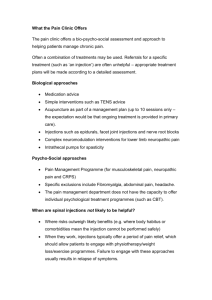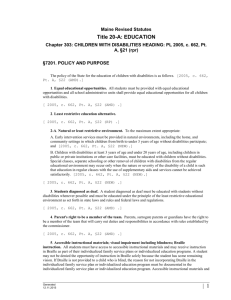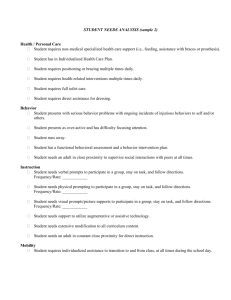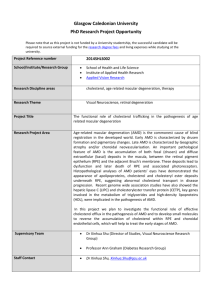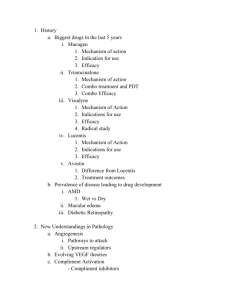Cost-effectiveness analysis of individualized versus standardized
advertisement
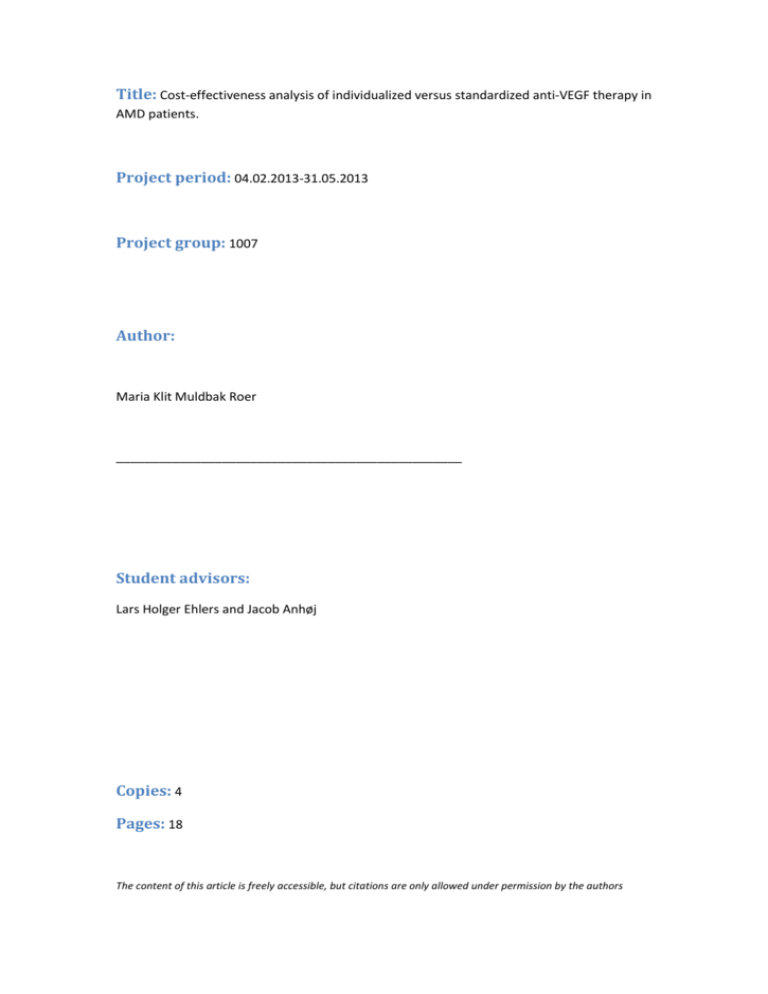
Title: Cost-effectiveness analysis of individualized versus standardized anti-VEGF therapy in AMD patients. Project period: 04.02.2013-31.05.2013 Project group: 1007 Author: Maria Klit Muldbak Roer _________________________________________________ Student advisors: Lars Holger Ehlers and Jacob Anhøj Copies: 4 Pages: 18 The content of this article is freely accessible, but citations are only allowed under permission by the authors Aalborg University Cost-effectiveness analysis of individualized versus standardized anti-VEGF therapy for AMD patients Maria Klit Muldbak Roer ABSTRACT Introduction: Age-related Macular Degeneration (AMD) is the leading cause of vision loss among people at 60 years or above in the developed countries3. The recommended treatment has, until now, been a standardized therapy procedure. But new evidence suggests that the patients will have more benefit from an individualized therapy. Objective: To compare cost and health consequences in AMD patients receiving anti-VEGF treatment in standardized therapy of three injections or individualized therapy of injection only by indication, by combining statistical process control (SPC) and cost-effectiveness analysis (CEA) Method: SPC is used to evaluate the process for a given period of time. On the basis of the SPC, a CEA was performed by use of a decision analytic model to compare the standardized therapy with individualized therapy. The model begins when the patients receive the first injection or control visit and the effect measure is infections averted. A probabilistic sensitivity analysis (PSA) was made to evaluate the result. Results: The SPC illustrate that there was a drop in number of injections after the individualized therapy was implemented. The CEA showed a cost saving on 5% and a probability on 0.133% of infections averted. Conclusion: This analysis implies that the individualized therapy is the preferred strategy because it is both cost-reducing and quality-increasing. But because of the unstable SPC process further evaluation is recommended. KEYWORDS Age-related macular degeneration, statistical process control, decision analytic model, costeffectiveness analysis. LIST OF ABBREVIATIONS Age related macular degeneration (AMD), anti-vascular endothelia growth factor (anti-VEGF), Aalborg University Hospital (AUH), cost effectiveness analysis (CEA), incremental costeffectiveness ratio (ICER), probabilistic sensitivity analysis (PSA), statistical process control (SPC). 1 Aalborg University 2 Aalborg University 1.0 PREFACE The aim of this preface is to explain the course of this project. The AMD clinic is a part of Aalborg University Hospital (AUH) and treats patients with Agerelated Macular Degeneration (AMD). The AMD clinic has been through a period with more than one change, which I will account for in this preface. The original intervention at the AMD clinic was a project about relational coordination directed by research centre for welfare management. The project was based on the American Professor Jody Hoffer Gittell’s theories about characterization of a well-functional health care system, which include evidence based studies that show a connection between the quality of treatment, the time for hospitalization and the quality of relational coordination1. The aim was to investigate, try out and disseminate methods to increase the ability to relational coordinating in a Danish context2. The motivation for the AMD clinic to participate in the project was learning, improved logistics, and the necessity of treating more patients. The project at the AMD clinic consisted of optimizing of continuity of care and relational coordinating. This would be done by generating a common knowledge about all procedures and thus achieve that all staff groups could perform all the procedures they are qualified for. In this way the functions between doctors, nurses and photographers would be more overlapping, which should result in benefit for the patient, and better continuity of care. After initiating the project, it did not turn out to be the optimal method for optimizing of continuity of care. Various challenging tasks occurred, among them inappropriate continuity of care, because the nurse started-up the patients but when the patient was ready to be seen by the doctor, the doctor was doing other tasks. Therefore the AMD clinic chose to find other solutions, and with the new focus on continuity of care, it resulted in another change introduced by the AMD clinic itself. The focus in the new strategy was to treat the patients on the basis of new evidence, which demonstrated that the optimal way to treat patients was to give injections by indication instead of series of three and thereby individualizing therapy. Furthermore the AMD clinic expected that the individual therapy would result in a possibility to treat more patients, which they thought was needed by the increasing number of AMD patients. Beside the continuity of care the AMD clinic began to give patients new appointments after the end of each visit instead of sending them by letter. The original aim of this part was to save money in postage, but it further resulted in a decreased number of patients which cancelled or absented from injections. Whether or not this decrease is a consequence of the new way to give patients their appointments or the individual therapy is unknown. Furthermore, it should be mentioned, that at changed appointment is counted as canceled appointment, which could be a bias. I entered the project from the sideline and should try to make head or tail of vague changes. My supervisor and the head of the eye department initially suggested that I looked at the available data and tried to use statistical process control (SPC) to analyze the changes. We also discussed the possibility of combining SPC and health economic evaluation, to investigate whether or not the changed patient pathway at the AMD clinic was cost-effective. The original aim of my project at the AMD clinic was based on the first intervention about relational coordination. But since this intervention failed and no data was collected I chose to reformulate 3 Aalborg University the aim. The new aim was to analyze the individualized therapy introduced by the AMD clinic itself. But what looked like a straightforward assignment turned out to include various challenges. Among others I found that the AMD clinic did not consider the changes thoroughly enough. First, the AMD clinic did not have any clear objective for what they would attain by the intervention. Second, they had no parameters they chose to measure on, which meant that they had no data collected beside the data they are committed to report to the Danish National Hospital Discharge Register. They only had an overall purpose, which was to treat more patients. Because of the missing objective and data about the intervention, this analysis is based on data from the Danish National Hospital Discharge Register. But the Danish National Hospital Discharge Register has limitations too. Among them the quality of data seems inferior and deficient. Furthermore the data is registered in a way which makes some analyses very difficult. Because of the limitations in the data the analysis and model in this study have been changes several times. But the data is used in the most applicable way. 2.0 INTRODUCTION Age-related Macular Degeneration (AMD) is the leading cause of vision loss among people age 60 or above in the developed countries3. It is a chronic condition which affects the macular. The macular, also known as the yellow spot, is responsible for the central vision and is located in the retina, which is the light-sensitive tissue of the eye. AMD is divided in two clinical subtypes, a dry and a wet form. The dry form account for 85%4 of the cases and is caused by a condition called drusen in the macular which results in damage of the cells. There is yet no medical treatment for dry AMD, but a clinical study conducted by the National Eye Institute shows that some patients have benefit from a high dose of vitamins and minerals5. The wet form account for 15%4 and occurs when the eye tries to regenerate the damaged cells by formation of small new blood vessels in the choroid. These vessels are thin-walled and leaky which result in sub retinal bleeding which affects the macular and causes blindness of the central vision.3 There is no cure for wet AMD either, but since 2000 it has been possible to prevent or delay its progression by medical treatment4. It is assumed that about 10%6 of the people aged 60 years or older in Denmark have AMD. Furthermore it is assumed that 2,2007 new patients will start for treatment in Denmark every year and the number is expected to increase by the increasing number of senior citizens6. Without treatment those patients will experience blindness of the central vision3. The standard treatment for wet AMD in Denmark is an injection with an anti-vascular endothelia growth factor (anti-VEGF) (Lucentis®)8 which works by inhibiting the growth of new blood vessels.4 This injection is given directly in the eye which often results in both discomforts for the patient and a risk of infection. Furthermore the treatment is not curative but only last for a period, typical one or two months. That means that the injection should be repeated regularly for the rest of the patient’s life, unless the patient’s vision is assessed to be too impaired for therapy. So far, international guidelines have recommended a standard procedure for Lucentis® therapy consisting of a series of three injections (one injection each month for three months). Subsequently, the following treatment pathway consisted of a control visit possibly followed by a new series of three injections.7 But new evidence illustrate that it is better to treat patients individually and only give injection by indication instead of the standardized therapy with injections in series of three. When injections are given by indication only, the risk for infection I 4 Aalborg University decreased, and thus the quality of the treatment is sustained.9,10 Furthermore the cost might be reduced by removing unnecessary and expensive injections. This new evidence lead to that the AMD clinic at Aalborg University Hospital (AUH) implemented this new treatment strategy, where they had gone from the standardized therapy of injection in series of three at successive ambulant visits to an individualized therapy of combining control visits to an individual assessment of the need for injection. The purpose of this study is therefore to compare cost and health consequences in AMD patients receiving anti-VEGF treatment in standardized therapy of three injections or individualized therapy of injection only by indication, by combining statistical process control (SPC) and cost-effectiveness analysis (CEA). 3.0 METHOD This CEA analysis applies a decision analytic model to compare the average cost and health consequences for one patient in the two alternative therapy groups, the standardized versus the individualized therapy, for AMD treatment. SPC is used to analyzing the process data (See appendix A).The international guidelines for economic evaluation are combined with SPC to evaluate the change, which AMD clinic had implemented. TreeAge Pro software, version 2012, was used to construct the decision model. This study is conducted in collaboration with the AMD clinic at AUH, where the standardized therapy was replaced by individualized therapy, September 3th 2012. The two different procedures are illustrated below in Figure 1. The standardized therapy is characterized by treatment of a series of three injections (one injection each month for three months), followed by a control visit. Afterwards the patients follow a standard treatment of either a further control visit or injections in series of three. In contrast the individualized therapy is characterized by an appointment for control visit, and here the patients are injected only by indication. That means that all patients are treated individually. Standardized therapy: Pre.exam. 3 inj. 3 inj. Control Control Control Control e.g. inj. Control e.g. inj. Control Individualized therapy: Pre.exam. 2-3 inj. Control e.g. inj. Figure 1 Illustration of the two procedures. At the top the standardized therapy where the patient receives injections in series of three, followed by a control visit. At the bottom, the individualized therapy where the patient always has an appointment for control visits, and injected only by indication. 5 Aalborg University The analysis involves anonymous data collected from the Danish National Hospital Discharge Register containing information about the number of injections performed in the AMD clinic at AUH in the period from September 5th 2011 to March 3th 2013. Data is given on week basis. 3.1 Statistical process control The run chart for number of injections is illustrated in Figure 2. The x-axis indicates the time, given by week and the y-axis indicates the number of injections. Data was collected over a 78 weeks period, of which 52 weeks was before the intervention. The median is calculated on the basic of the 52 weeks and is illustrated as the horizontal line. After the intervention the median is illustrated as a dotted line. This median illustrates a very unstable period with an increased number of injections before the change. The AMD clinic has no explanation for the increased number of injections before the change. The baseline median should be calculated on the basis of the latest stable period before an intervention, and contain at least 20 measurement points. Therefore the baseline period is calculated on the basis of the last 24 weeks before the intervention. The new median was calculated and data were plotted in the chart. The time of the changes starts were the median become a dotted line. Figure 4 If the process only demonstrates common cause variation, the data points will be distributed evenly around the median. A signal will be intercepted if the process start changing and indicate special cause variation. The observed signals in this study are the shift and cross signals. For the analysis there were a total of 50 data points of which 47 were applicable data points, because three of the data points lie on the median. Accordingly, given by the table, the threshold value for the shift signal is maximum nine and the threshold value for cross signal is minimum 17 (Appendix B). 75 70 65 Measure 60 55 50 45 40 35 30 36-2011 39-2011 42-2011 45-2011 48-2011 51-2011 02-2012 05-2012 08-2012 11-2012 14-2012 17-2012 20-2012 23-2012 26-2012 29-2012 32-2012 35-2012 38-2012 41-2012 44-2012 47-2012 50-2012 01-2013 04-2013 07-2013 25 Time/order Figure 2 Run chart for number of injections. A total of 78 points was collected. The red line illustrate the median calculated on the basis of week 36 2011 to week 35 2012 which is before the change. The dotted line is a continuation of the median. 6 Aalborg University 3.2 Cost-effectiveness analysis 3.2.1 Decision analytic model A healthcare sector perspective was applied and the wet AMD patient entered the model by first injection or control visit at the AMD clinic. The decision analytic model calculates the expected mean costs and the effects by the standardized and individualized therapy for one patient in treatment for wet AMD for a period of six months. The result of the model is presented as an ICER, which outline the extra costs which is needed to achieve an extra health gain with the marginal best technology. Furthermore a cost-effectiveness plan would be applied to visualize a cohort of 10,000 ICERs to illustrate relationship of cost and effects between the different strategies. The tree is illustrated in Figure 3 and the applied probabilities and costs are presented in Error! Reference source not found. and Error! Reference source not found.. Figure 3 The decision analytic model. Uppermost branch illustrate the standardized therapy where the patients receive injections in series of three followed by a control visit. Lowermost branch illustrate the individualized therapy where the patients always have an appointment for control visit, and are injected only by indication. 3.2.2 Probability estimate The probability estimates and their distributions are listed in Table 1. Data collected from the Danish National Hospital Discharge Register at AMD clinic at AUH is used to estimate the mean number of injections for the two therapy alternatives. For a six month period in the standardized therapy a patient received on average 3.04 injections. For the individualized therapy a patient received on average 2.53 injections. The control visit was estimated on the basic of the therapy form, and it is presume that the patient visit the AMD clinic once a month. Literature based estimate were used to determine the risk for infection. For the literature review, the searched databases were Cochrane, Embase, and PubMed, and the search terms were: ((“Age-related macular degeneration” [Mesh]) OR AMD ) and additionally with “costeffectiveness”, “prevention”, “control”, “standard practice”, “treatment recommendation”, “Guidelines”, “complications”. The best available evidence was used and the risk for infection is estimated at 0.26125%11 per injection, which give a patient a probability for no infection at the standardized therapy at: 1 − (3.04 ∗ 0.0026125) = 0.992058 And for the individualized therapy at: 1 − (2.53 ∗ 0.0026125) = 0.993391 7 Aalborg University Probabilities Standardized therapy Injections Control Infection Individualized therapy Injections Control Infection Baseline Estimate Distributions Reference 3.04 3.00 0.0026125 0.380 0.375 0.00032656 AMD clinic, AUH See text 11 2.53 6.00 0.0026125 0.316 0.750 0.00032656 AMD clinic, AUH See text 11 Table 1 Probabilities of injection, control and infections for the standardized and the individualized therapy. Baseline estimate together with distributions calculated on the basis of plausible ranges. 3.2.3 Cost estimates The cost estimates were obtained from the Danish Diagnosis Related Group (DRG) 12 and are listed in Error! Reference source not found.. The cost for injection and control are equal for both the standardized and the individualized therapy. For injection the procedure codes are DH353J and KCKD05B with a total cost at 13,351 DKK. For control the procedure codes are DH353J and ZZ7035 with a total cost at 1,325 DKK. Costs Injection Control Baseline Estimate 13,351 1,325 Distributions Reference 1,668.875 165.625 12 12 Table 2 Costs covering the injection and control visit. Baseline estimates together with distributions calculated on the basis of plausible ranges. All costs are DKK in 2013 value. 3.2.4 Sensitivity analysis and uncertainty A sensitivity analysis was performed to account for uncertainty in this model and to evaluate the robustness of the result. A probabilistic sensitivity analysis (PSA) was conducted to estimate the overall parameter uncertainty in the ICER. A plausible range of +/- 12.5% was used regarding the PSA. 4.0 Results The individualized therapy seems cost-effective with both quality-increasing and cost-reducing. Because of the fewer injections in the individualized therapy the risk for infection slightly decreases and because of the very expensive treatment the average cost of individualized therapy is lower. Furthermore there is a drop in number of injections after the change in treatment at the AMD clinic, see Figure 4. 4.1 Statistical process control The SPC is used to illustrate the number of injections for a given period. There were a total of 50 weeks from week 12 2012 to week 09 2013 analyzed. The run chart for number of injections is illustrated in Figure 4. 8 Aalborg University 75 70 65 Measure 60 55 50 45 40 35 30 08-2013 06-2013 04-2013 02-2013 52-2012 50-2012 48-2012 46-2012 44-2012 42-2012 40-2012 38-2012 36-2012 34-2012 32-2012 30-2012 28-2012 26-2012 24-2012 22-2012 20-2012 18-2012 16-2012 14-2012 12-2012 25 Time/order Figure 4 Run chart for number of injections. A total of 50 points is studied. The red line illustrate the median calculated on the basis of week 12 2012 to week 35 2012. The dotted line is a continuation of the median. The green line illustrate the median from week 36 2012 to week 09 2013, which is after the individualized therapy was implemented. The baseline period were based on the latest 24 weeks before the change. The median is calculated on the basic of the baseline period and is 59.0. The number of applicable plots is 47, since three of the plots lie on the median. The number of times the curve cross the median is 13 and thereby exceeds the threshold value at minimum 17 crosses. The longest run is 17, and thereby exceeds the threshold value at maximum nine. Both number of crosses and longest run indicates a signal of special cause variation. The signal appears from week 34 2012 to week 50 2012, which is after implementing of individualized therapy. Seen at the Figure 4 it also seems that there are fewer injections after the changes in treatment than before. There is a drop in the median from 59.0 to 52.0 after the changes. There are two extreme points after the change, a very high peak at week 51 2012 at 73 injections and a very low peak at week 52 2012 at 27 injections. 4.2 Cost-effectiveness analysis The decision analytic model indicated that the individualized therapy is the preferred program compared to the standardized therapy. The expected value of the individualized therapy is 41,728 DKK per 0.99339 infection averted and for the standardized therapy the expected value is 43,237 DKK per 0.99206 infection averted. The model covers costs and effects for only one patient in a period of six month. The individualized therapy is cheaper and the risk for infections is slightly decreased compared to the standardized therapy, see Table 3. 9 Aalborg University Cost Risk for infection Probability of no infection Individualized 41,728.03 0.006609 0.99339 Standardized 44,028.00 0.007942 0.99206 Infection averted 0.00133 (0.133%) Individualized vs. standardized Incremental cost -2,299.97 (5% saved) Individualized vs. standardized Table 3 The calculated costs and effects of the standardized and individualized therapy. Furthermore, the calculation of infections averted and costs compared between the standardized and individualized therapy (calculated as percentage). All costs are DKK in 2013 value. The ICER is calculated on the basic of the result from the decision analytic model, and is shown below: 𝐼𝐶𝐸𝑅 = 41,728.03 − 44,028.00 0.84 − 0.81 = −76,665.67 The ICER is -76,665.67 DKK, which is the price for a gained unit. It demonstrates that the individualized therapy is the cost saving program compared to the standardized therapy. Further the individualized therapy is also most quality-increasing alternative. 4.3 sensitivity analysis and uncertainty On the basic of the decision analytic model a PSA was performed with sensitivity at the costs and effects at +/- 12.5%. A cost-effectiveness plan with a cohort of 10,000 ICER pairs is composed to evaluate whether the new continuity of care is dominant or not. See Figure 5. 10 Aalborg University Figure 5 Cost-effectiveness plane which illustrates 10,000 incremental cost-effectiveness ratios (ICER) pairs. The ICER was calculated between the individualized and standardized therapy. 22% of the plots are located in the first quadrant which indicates quality-increasing and cost-increasing. 63% of the plots are located in the second quadrant which indicates quality-increasing and cost-reducing. 15% of the plots are located in the fourth quadrant which indicates quality-decreasing and cost-increasing. The plots are located respectively in first, second and fourth quadrant Figure 5. 22% of the ICERs are located in the first quadrant which indicates that the individualized therapy is qualityincreasing but also cost-increasing. 63% of the ICERs are located in the second quadrant which indicate that the individualized therapy dominant with both quality-increasing and costreducing. 15% of the ICERs are located in the fourth quadrant which means that the standardized therapy dominant because the individualized therapy is both quality-decreasing and cost-increasing. 5.0 Discussion This analysis demonstrates that the individualized therapy is the preferred strategy. The PSA illustrate that in 63% of the mean ICERs the individualized therapy has a probability of both costreducing and quality-increasing. The SPC indicate a drop in injections after the AMD clinic implemented the individualized therapy. The combination of SPC and CEA seems like an optimal way to analyze healthcare interventions. 11 Aalborg University A signal of special cause variation appears from week 34 2012 to week 50 2012, where the number of injections decreased. This special cause variation appears after implementing of the individualized therapy, and could be a result from the changes. After the individualized therapy was implemented the number of injections decreased. The median drops from 59.0 to 52.0, which is an expression for a drop in number of injections. It can further bee seen if the number of injections is compared to number of patients. In a period of 26 weeks before the implementing of the individualized therapy were given 1,499 injections shared among 493 patients while in a period of 26 weeks after the implementing of individualized therapy there were given 1,260 injections shared among 498 patients. This gives a drop in injections of 16%. The AMD clinic did not change the already planned treatment before the change was implemented. Therefore the already planned injections were not changed, and the drop in injections will therefore be seen as a more soft drop instead of a more significant one immediately after the individualized therapy where introduced. All in all it seems like the number of injections decreases. There is especially a very high peak at week 51 2012 at 73 injections and a very low peak at week 52 2012 at 27 injections. The very high peak could be due to that it was the week before Christmas were the AMD clinic had to treat more patients because of a following week with more days off, which lead to the very low peak the following week. Seen at the period of individualized therapy separately, the calculated median for this period (the green line illustrated in Figure 4) illustrate only common cause variation, which is a natural part of the process. Furthermore the staff, equipment, facilities and type of patients have been the same before and after the change in treatment. If investigating the SPC separately it seems that the intervention has had the desired effect. Even though the SPC indicates an improvement in treatment of AMD, further investigation is needed to provide the decreased number of injections. It is recommended, that the number of injections is followed for an even longer period of time. According the CEA the Individualized therapy seems like the optimal treatment method. The CEA indicate that the individualized therapy, from a hospital perspective, could have a costreducing of 2,299.97 DKK per patient per six month. Furthermore, the risk for infection is slightly decreased because the patients have fewer injections. Based on the PSA, 63% of ICERs lies in second quadrant which indicates that it is both cost-reducing and quality increasing. There are several limitations and assumptions related to the decision analytic model. It is in this study presumed that the effect of the treatment is equal. Even though this assumption is based on evidence, it would have been preferred to make a randomized control trial at AUH to document this in the setting. Furthermore there was no range of distributions on the data which is why the distributions were set to +/- 12.5%. This could be another limitation because it is uncertain whether this is too less or too much. Another significant limitation of this study is the decision model. This decision model is very simple and several events are left out of the model. If another model were applied it would have been more convincing. The preferred model would have been a Markov model, because it is able to handle more complex processes happening over time. Furthermore the Markov model is more appropriate in case of recurring processes and for chronic conditions, which AMD is. The Markov model further allows the patient to move from one state to another.13 But a limitation to build the Markov model is that the quality of data had been deficient and inferior. This could be due to, that the AMD clinic did not have any clear aim of what they would achieve by the changes, before they started the changes. Therefore the AMD clinic had no data collected with the exception of the data they are 12 Aalborg University committed to. Further it is assumed that there were no costs related to implementing the individualized therapy. Several CEAs, which compare two or more different pharmaceutical treatments, have found that ranibizumab which is the active substance in Lucentis® is the preferred for AMD treatment.14 Through my literature review I only found few studies, which compare and evaluate the administration of a single pharmaceutical treatment.9,10 But none of these studies performed a CEA to evaluate the economic potential for the administration of the treatment. Finally, to my knowledge this kind of analysis, where CEA is combined with SPC for quality improvements interventions has not been seen before. Even though this study is insufficient it should be seen as a test, which illustrates a great potential for using SPC in combination with CEA. This combination could in various aspects be applied as a potential method for analysis in healthcare improvement. One of the advantages is, that the SPC illustrate whether the studied process had changed for a period of time, and further it can be evaluated if the process is satisfactorily. This, contemporary with that the economic perspective is evaluated. Both of these aspects are very important in healthcare quality improvement. 6.0 Conclusion The individualized therapy is the preferred strategy for AMD treatment. The CEA indicate that the individualized therapy both is cost-reducing and quality increasing. The SPC illustrate a drop in number of injections. The combination of CEA and SPC shows a great potential for analysis in healthcare improvement. 7.0 Acknowledgement I wish to thank Lars Holger Ehlers and Jacob Anhøj for supervising this project. Likewise, I would like to thank Kirsten Lau Baggesen and Helle Jepsen at the AMD clinic, AUH who has been very helpful with data collection for this analysis. 13 Aalborg University 8.0 List of references 1. Gittell, Jody h. Effektivitet I sundhedsvæsenet – samarbejde, flexibilitet og kvalitet. København: Munksgaard|bøger, 2012. ISBN: 9788762811362. 2. Videncenter for Velfærdsledelse – projekter – relationel koordinering [Internet]. [Sited 2013 februar 5]; Available from: http://www.velfaerdsledelse.dk/projekter/1322054209. 3. Cheung L, Eaton A. Age-Related Macular degeneration. Pharmacotherapy Volume 85, Number 261, 2013. 4. Thomas M, Mouse S, Mousa S. comparative effectiveness of aflibercept for the treatment of patients with neovascular age-related macular degeneration. Clinical Opthalmology 2013:7, 495-501. 5. Bressler NM, Bressler SB, Congdon NG, Ferris FL 3rd, Fridman DS, et.al. Potential public health impact of Age-Related Eye Disease Study results: AREDS Report no. 11. Arch Opthalmol, 2003 Nov; 121 (11): 1621-4. 6. SBB, ML. Glostrup Hospital. 2012 July 10 [Internet]. [Sited 2013, Feb 10]. Available from: http://www.glostruphospital.dk/menu/Afdelinger/Ojenafdelingen/Oculus/AMD1.htm. 7. Dansk Oftalmologisk Selskab [Internet]. [Sited 2013, Feb 10] Available from: http://www.dansk-oftamologisk-selskab.dk/. 8. Sundhedsstyrelsen. Intravitreal angiostatisk behandling af neovaskulær (våd) aldersrelateret macula degeneration (anti-VEGF-behandling). Version 1.0; 2006 Nov. 29 [Internet]. [Sited 2013 Feb. 10]. Available from: http://www.sst.dk/Udgivelser/2006/Intravitreal%20angiostatisk%20behandling%20af%2 0neovaskulaer%20vaad%20aldersrelateret%20maculadegeneration%20anti-VEGFbehandling.aspx. 9. Cruess A, Berg A, Colleaux K, Greve M, Harvey P. Canadian expert consensus: optimal treatment of neovascular age-related macular degeneration. Can J Ophthalmol –vol. 47, No. 3, June 2012. 10. Framme C, Wolf-Schnurrbusch U, Lobsiger H, Bayer S, Wolf S. Angepasstes und standardisiertes Patientenmanagement bei der Behandlung der neovaskulären AMD im ambulanten Bereich einer Universitäta-Augenklinik. Klin Monatsbl Augenheilked 2012; 229: 812-821. 11. Rosenfeld P, Brown D, Heier J, Boyer D, Kaiser P. et.al. Ranibizumab for Neovascular Agerelated Macular Degeneration. The New Englan Jurnal of Medicine, 2006; 355: 1419-31. 12. Visuel DRG [Internet]: http://drgservice.sst.dk/grouper/Modules/home/Report.aspx. [sited 2013 April 1]. 13. Fox-Rushby J, Cairns J. Economic Evaluation. Open University Press|book. 2005. 14. Mitchell P, Annemans L, White R, Gallagher M, Thomas S. Cost Effectiveness of Treatments for Wet Age-related Macular Degeneration. Pharmacoeconomics 2011; 29 (2): 107-131. 15. Anhøj J. Noter om seriediagrammet. 2013 January 17 [Send by mail]. 14 Aalborg University 16. Perla R, Provost L, Murray S. The run chart: a simple analytical tool for learning from variation in healthcare processes. BMJ Qual Saf 2011; 20: 46-51. 17. Benneyan JC, Lloyd RC, Plsek PE. Statistical process control as a tool for research and healthcare improvement. Qual Saf Health Care 2003; 12: 458-464. 18. Anhøj J, Bjørn B. Statistisk processtyring I sundhedsvæsenet. Ugeskr Læger 171/21. 18. maj 2009. 19. Andersen S, Kjærgaard J. Kontrolkort – et nyttigt, grafisk redskab til analyse af processers variation over tid. Ugeskr Læger 171/11. 9. Marts 2009. 20. Anhøj J. Run charts revisited: A simulation study to propose a balanced set of run chart rules for detection of non-random variation in health care processes. In review. 21. Drummond M, Sculper M, Torrance G, O’Brien B, Stoddart G. Methods for the Economic Evaluation of Health Care Programmes |Bog. 2006. 22. Weintraub W, Choen d. the Limits of Cotst-Effectiveness Analysis. Circ Cardiovasc Qual Outcome 2009; 2: 55-58 15 Aalborg University 9.0 Appendix 9.1 Appendix A Theory of Statistical process control and cost-effectiveness analysis Statistical process control Statistical process control (SPC) is a simple way to show whether the investigated processes are stable or changing. SPC use graphical methods to describe and analyze the variation of a process in a given time. It makes it, with relative few measurements, possible to distinguish between common cause variation, which is a natural part of the process, and special cause variation, which often can be explained as extraneous impact of the process. Overall, the SPC make use of two types of charts, the run chart and the control charts. The chosen chart for this study is the run chart. 15,16,17 The run chart is a simple way to illustrate a process over time. It does not require special types of data and probability distribution and only uses minimal mathematical complexity. It is simple to construct and is easy interpreted. Unlike statistical tests that compare two or more sets of data, the run chart requires no statistics to determine whether change in the process affect the outcome. And further, unlike statistical tests, the SPC maintain the time order of data.15,18,19 The run chart is very easy and simple to construct, with time given at the x-axis and the indicator value at the y-axis. The median is used as the centerline, and is not influenced by extreme values. The data points are plotted in the chart. The process is said to be stable, if the data points is allocated randomly around the centerline. If special pattern appear in the distribution of the data points it is called signals. These signals indicate special cause variation, and mainly two types of signals are interesting to determine special cause variation. One of these signals is the shift signal, which occurs by exceptional many data points appear contiguous at the same side of the median. The other signal is the cross signal, which occurs by exceptional few cross of the median. Both the shift signal and the cross signal occur when the threshold value for those signals is exceeded. The threshold value is established by the total number of applicable data points in the chart. Useless data points are categorized as those which lie on the median. A table is applied for statement of the threshold limit value15 (Appendix B). Other, not often used, signals are the cyclical pattern and the trend signal. The cyclical patterns occur e.g. in case of season variation. The cyclical pattern is rarely used in healthcare and should be used carefully, because some people will often over or under react to a single value. The trend signals occur when an exceptional long run of data points either rise or fall. The trend signal is a very discussed signal and some mean that it provides a false signal and because of that it is not a recommended signal for an analyze in healthcare.15,16,17,19,20 Cost-effectiveness analysis A cost –effectiveness analysis (CEA) is an often used decision-making assistance tool in healthcare economy. It compares cost and consequences of two or more health alternatives and support decision-maker to identify the economically most efficient alternative. All costs and consequences are identified, measured and appraised which form the basis of choosing the most cost-effective strategy. The incremental cost-effectiveness ratio (ICER) is an equation which illustrates the ratio of the change in cost to incremental benefits.21 The result of the ICER is only 16 Aalborg University given as a single number which can be influenced by assumptions. Since assumptions almost always will be included in a CEA it is preferred to perform a sensitivity analysis, which is a way to investigate the uncertainties and robustness of the outcome. In the sensitivity analysis distributions at both costs and effects are calculated. That gives the possibility to calculate more than one ICER. These ICERs can for example be displayed in a cost effectiveness plan to illustrate in which quadrant the plots are distributed. Other plans and curves can also be applied for illustrating the result of the ICERs.22 There are several ways in which a CEA can be used. Besides identifying the most efficient alternative before implementing, the CEA could also be used to post evaluate an already implemented strategy.21 For a CEA a decision model is often used to calculate and illustrate the result, because the models are very appropriate for handle large amount of data and calculations.13 17 Aalborg University 9.2 Appendix B Table for threshold value for longest run and number of cross in the run chart15 Number of useful Upper prediction limit for Lower prediction for number observations longest run of crossings 65 9 25 66 9 26 67 9 26 67 9 27 69 9 27 70 9 28 71 9 28 72 9 29 73 9 29 74 9 29 75 9 30 76 9 30 77 9 31 78 9 31 79 9 32 80 9 32 81 9 33 82 9 33 83 9 34 84 9 34 85 9 34 86 9 35 87 9 35 88 9 36 89 9 36 90 9 37 91 10 37 92 10 38 93 10 38 94 10 39 95 10 39 96 10 39 97 10 40 98 10 40 99 10 41 100 10 41 18
